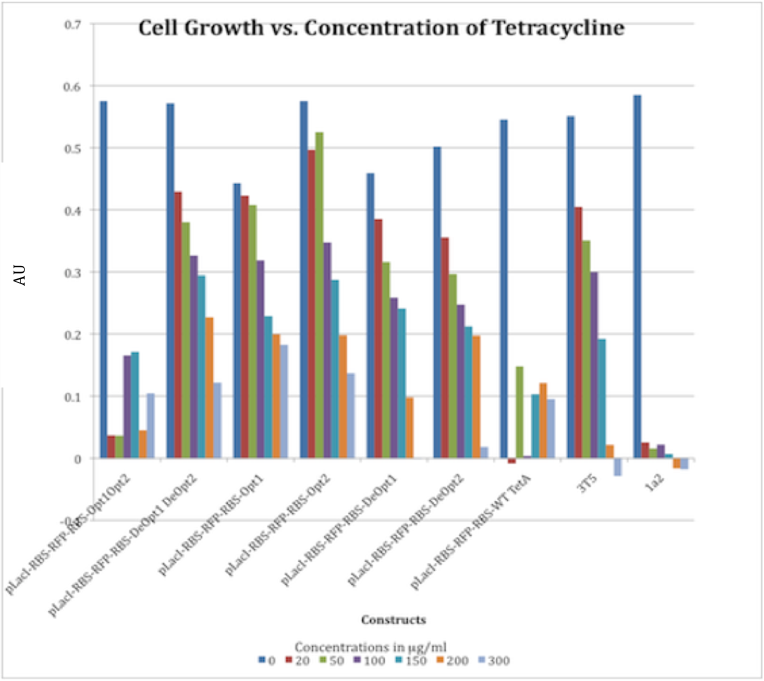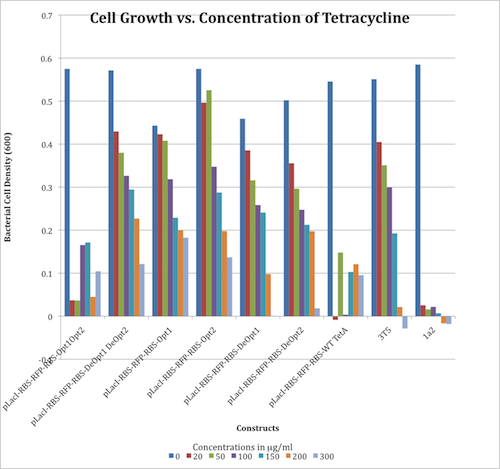Team:Davidson-MissouriW/OptimizingCodons
From 2010.igem.org
Contents |
Optimizing Codons
Introduction
Creating Optimized and Deoptimized TetA
| Segment | Number of Base Pairs | Wild Type Sequence | Opt Seq | Deopt |
| 1 | 141 | AAAAAAA |
|
Template:Nowrap begin border="1" cellpadding="2" | Segment | Number of Base Pairs | Wild Type Sequence | Optimized Sequence | Deoptimized Sequence |
|---|---|---|---|---|---|
| 1 | 141 | Atgaaatctaacaatgcgctcatcgtcatcctcggcaccgtcaccctggatgctgtaggcataggcttggttatgccggtactgccgggcctcttgcgggatatcgtccattccgacagcatcgccagtcactatggcgtg | ATGAAATCTAACAACGCGCTGATCGTTATCCTGGGTACCGTTACCCTGGACGCGGTTGGTATCGGTCTGGTTATGCCGGTTCTGCCGGGTCTGCTGCGTGACATCGTTCACTCTGACTCTATCGCGTCTCACTACGGTGTT | ATGAAGAGTAATAATGCCCTAATAGTCATACTAGGAACAGTCACACTAGATGCCGTCGGAATAGGACTCGTCATGCCCGTCCTACCCGGACTACTAAGGGATATAGTCCATAGTGATAGTATAGCCAGTCATTATGGAGTC | |
| 2 | 138 | ctatatgcgttgatgcaatttctatgcgcacccgttctcggagcactgtccgaccgctttggccgccgcccagtcctgctcgcttcgctacttggagccactatcgactacgcgatcatggcgaccacacccgtcctg | CTGTACGCGCTGATGCAGTTCCTGTGCGCGCCGGTTCTGGGTGCGCTGTCTGACCGTTTCGGTCGTCGTCCGGTTCTGCTGGCGTCTCTGCTGGGTGCGACCATCGACTACGCGATCATGGCGACCACCCCGGTTCTG | CTATATGCCCTAATGCAATTTCTATGTGCCCCCGTCCTAGGAGCCCTAAGTGATAGGTTTGGAAGGAGGCCCGTCCTACTAGCCAGTCTACTAGGAGCCACAATAGATTATGCCATAATGGCCACAACACCCGTCCTA |
Note: All above segments have been optimized and deoptimized using the online [http://genomes.urv.es/OPTIMIZER/ Optimizer] program.
To create the optimized and deoptimized segments of the Tet A gene we used the sequence that the Optimizer program gave us and put it into the [http://gcat.davidson.edu/IGEM06/oligo.html Lancelator] a program created by Lance Harden as part of the 2006 iGEM team. After getting the recommended Oligo sequences from the Lancelator, we added necessary "sticky ends" that were compatible with the naturally occurring restriction enzyme sites that we discovered (see Restriction Enzymes below). At this time we have ordered Oligo parts for segments 1 and 2 of the Tet A gene. The Oligos that were ordered can be seen below.
Segment 1 Oligos
Optimized
top 1 5' AATTCGCGGCCGCTTCTAGATGAAATCTAACAACGCGCTGATCGTTATCCTGGGTACCG 3’
top 2 5' TTACCCTGGACGCGGTTGGTATCGGTCTGGTTATGCCGGTTCTGCCGGGTCTGCTGCGTGAC 3’
top 3 5' ATCGTTCACTCTGACTCTATCGCGTCTCACTACGGTGTTCTG 3’
bottom 2 5' CATAACCAGACCGATACCAACCGCGTCCAGGGTAACGGTAC CCAGGATAACGATCAGCGCGTTGTTAGATTTCATCTAGAAGCGGCCGCG 3’
bottom 1 5' CTAGCAGAACACCGTAGTGAGACGCGATAGAGTCAGAGTGAACGATGTCACGCAGCAGACCCGGCAGAACCGG 3’
Deoptimized
top 1 5' AATTCGCGGCCGCTTCTAGATGAAGAGTAATAATGCCCTAATAGTCATACTAGGAACAG 3’
top 2 5' TCACACTAGATGCCGTCGGAATAGGACTCGTCATGCCCGTCCTACCCGGACTACTAAGGGA 3’
top 3 5' TATAGTCCATAGTGATAGTATAGCCAGTCATTATGGAGTCCTG 3’
bottom 2 5' GAGTCCTATTCCGACGGCATCTAGTGTGACTGTTCCTAGTATG ACTATTAGGGCATTATTACTCTTCATCTAGAAGCGGCCGCG 3’
bottom 1 5' CTAGCAGGACTCCATAATGACTGGCTATACTATCACTATGGACTATATCCCTTAGTAGTCCGGGTAGGACGGGCATGAC 3’
Segment 2 Oligos
Optimized
top 1 5' CTAGCCTGTACGCGCTGATGCAGTTCCTGTGCGCGCCGGTTCTGGGTGCGCTGTCTGAC 3’
top 2 5' CGTTTCGGTCGTCGTCCGGTTCTGCTGGCGTCTCTGCTGGGTGCGACCATCGACTAC 3’
top 3 5' GCGATCATGGCGACCACCCCGGTTCTGTG 3’
bottom 1 5' GCGCACAGGAACTGCATCAGCGCGTACAGG 3’
bottom 2 5' CCAGCAGAACCGGACGACGACCGAAACGGTCAGACAGCGCACCCAGAACCGGC 3’
bottom 3 5' GATCCACAGAACCGGGGTGGTCGCCATGATCGCGTAGTCGATGGTCGCACCCAGCAGAGACG 3’
Deoptimized
top 1 5' CTAGCGCTATATGCCCTAATGCAATTTCTATGTGCCCCCGTCCTAGGAGCCCTAAGTG 3'
top 2 5' ATAGGTTTGGAAGGAGGCCCGTCCTACTAGCCAGTCTACTAGGAGCCACAATAGAT 3'
top 3 5' TATGCCATAATGGCCACAACACCCGTCCTATG 3'
bottom 1 5' GGCACATAGAAATTGCATTAGGGCATATAGCG 3'
bottom 2 5' TAGGACGGGCCTCCTTCCAAACCTATCACTTAGGGCTCCTAGGACGGG 3'
bottom 3 5' GATCCATAGGACGGGTGTTGTGGCCATTATGGCATAATCTATTGTGGCTCCTAGTAGACTGGCTAG 3'
Restriction Enzymes
To insert the annealed Oligo segments that were created we had to digest the Tet A gene using naturally occurring enzyme restriction sites that did not exist in the rest of the gene or in the plasmid (pSBIA2).
| Segment | First Restriction Enzyme | Second Restriction Enzyme |
|---|---|---|
| 1 | EcoRI | NheI |
| 2 | NheI | BamHI |
| 3 | BamHI | SphI |
| 4 | SphI | SalI |
RFLP (Restriction Length Fragment Polymorphism)
We used restriction fragment length polymorphism (RFLP) as a way to screen our candidate clones for our optimized and deoptimized versions of the TetA gene. RFLP is a laboratory technique whereby DNA is digested by restriction enzymes and the resulting DNA fragments are separated by gel electrophoresis. RFLP relies on a difference between two or more samples of homologous DNA molecules arising from differing locations of restriction sites. Using the program [http://tools.neb.com/NEBcutter2/| NEBcutter V2] from New England Biolabs, we were able to determine which restriction enzymes to use to screen for our various TetA candidate clones. Based on availability of restriction enzymes and the greatest variability of bands created, we choose four different restriction enzymes for the custom digestion of our candidate clones:
Optimized segment 1→ HinFI
Deoptimized segment 2→ DdeI
Optimized segment 2→ BsaWI
Deoptimized segment 2→ AccI
Using RFLP, we screened our clones and sent strong candidate clones, the ones that had diagnostic bands indicative of the desired clone, off for sequencing. After analyzing the sequencing data, we were able to conclude that RFLP is an excellent method for screening for clones, given that almost all of the clones sent off were correct.
 "
"

